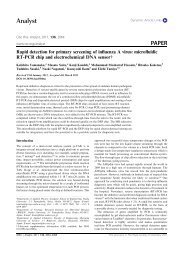SENSITIVE LABELLES IMPEDANCE IMMUNOSENSOR USING ...
SENSITIVE LABELLES IMPEDANCE IMMUNOSENSOR USING ...
SENSITIVE LABELLES IMPEDANCE IMMUNOSENSOR USING ...
Create successful ePaper yourself
Turn your PDF publications into a flip-book with our unique Google optimized e-Paper software.
Table 1. Sensitivity comparison of different techniques for PSA detection.DetectionmethodDetectionlimit (fg/mL)DescriptionRef.Electrochemical immunoassay 3000 Quantum dot (QD) functionalized graphene sheets(GS) were prepared and used as labelsElectrochemicalimmunoassaytransistor1000 The polystyrene doped PEDOT based OECT withAuNPs used as labelsNanowire sensor arrays 50 ÷ 100 Ab immobilized silicon nanowire field effectdevices were usedNanomechanical resonator 50 Harmonic oscillators used to measure the reductionin resonance frequency after antigen bindingAuNPs - based bio-barcode 0.09 AuNPs functionalized with hybridizedoligonucleotide barcodes were used[6][7][8][9][10]CONCLUSIONThe work concerns successful implementation of a simple and specific approach for ACT-PSA antibodyimmobilization onto AuNPs-modified carbon electrode surface of DEP chip via COOH group of SAM, which can serveas a linker for covalent biomolecular immobilization. The results indicated that AuNPs film deposited on the carbon inkworking electrode of DEP chip provide a highly active surface for the immobilization of PSA antibody molecules withmaintained immunoactivity. In addition, the used inexpensive DEP chip with carbon ink working electrode as basis forthe sensor will allow simple, disposable and portable instrumentation with low cost. Moreover, it was found that EIS isan impressive method and more simple than the other method for monitoring the interaction of antigen with antibody thatoccurred on the electrode surface.ACKNOWLEDGEMENTS: Dr. Truong TN Lien gratefully acknowledges the receipt of a grant from the NationalFoundation for Science and Technology Development (NAFOSTED), Vietnam, which enabled us to carry out the work.REFERENCES[1] Tudorache M, Bala C, Biosensors based on screen-printing technology and their applications in environmental andfood analysis, Anal BionalChem 388, pp. 565-568 (2007).[2]Lien T.N. Truong, Miyuki Chikae, Yoshiaki Ukita, YuzuruTakamura, Labelless impedance immunosensor based onpolypyrrole-pyrolecarboxylic acid copolymer for hCG detection, Talanta85, pp.2576-2579 (2011).[3] Truong TN Lien, Nguyen Xuan Viet, Miyuki Chikae, Yoshiaki Ukita, and YuzuruTakamura,Development oflabel-free impedimetrichCG-immunosensor using screen-printed electrode, J BiosensBiolectron, 2:3, 1000107 (2011).[4] Ionescu RE, Gondran C, Boiffier L, Renault NJ, Martelet C, et al.,Label-free impedimetricimmunosensor for sensitivedetection of atrazine,ElectrochimicaActa 55, pp. 6228-6231 (2010).[5] A. J. Bard, L.R. Faulkner,Electrochemical methods: Fundamental and applications, John Wiley & Sons, NewYork,1980.[6] Minghui Yang, AlirezaJavadi, andShaoqin Gong,Sensitive electrochemical immunosensor for the detection of cancerbiomarkerusing quantum dot functionalized graphene sheets as labels,Sensors and Actuators B155, pp. 357-360 (2011).[7] Duck-Jin Kim, Nae-Eung Lee, Joon-Shik Park, In-Jun Park, Jung-Gu Kim, and Hyoung J. Cho,Organicelectrochemical transistor based immunosensor for prostate specificantigen (PSA) detection using gold nanoparticles forsignal amplification,Biosensors and Bioelectronics 25, pp. 2477 (2010).[8] Zheng G, Patolsky F, Cui Y, Wang WU, and Lieber CM,Multiplexedelectrical detection of cancer markers withnanowire sensor, Nat Biotechnol23,pp. 1294 (2005).[9] Waggoner PS, Varshney M, and Craighead HG.,Detection ofprostate specific antigen with nanomechanicalresonators, Lab Chip9, pp. 3095 (2009).[10] Jwa-Min Nam, C. Shad Thaxton and Chad A. Mirkin,Nanoparticle-Based Bio-Bar Codes for the ultrasensitiveDetection of Proteins,Science301 (5641),pp. 1884 (2003).CONTACT*Truong Thi Ngoc Lien: truongtnlien@gmail.com or lientruong-iep@mail.hut.edu.vn1914




